
A self-proclaimed Obeah woman created this “Hoodoo Bones” reading tray. The tray utilizes a symbol from Brazilian Kimbanda in the center for Exu (who she claims is the same Eshu/Eleggua from Yoruban religion – which he isn’t). The orishas have nothing to do with hoodoo.
A popular phenomenon we’ve witnessed with the incredible amount of information available on the internet about Lucumí religion, is the cultural appropriation of Lucumí and Yoruban ritual elements by online merchants, Neo-Pagans and Eclectic Magical Workers claiming to be practicing hoodoo, voodoo, rootwork or obeah all at once. This phenomenon seems to be very prominent amongst professional workers who are peddling their services online, or more commonly with individuals selling “magical products” like oils, baths, incense, soaps, mojos, pakets, or even statues and sculptures made to look like orishas. This is not only completely out of alignment with traditional Santería Lucumí practice but it is very dangerous for spiritual reasons outlined below.
In this article we hope to demonstrate some of the examples the members of SAFE (Santeros Against Fraud and Exploitation) have seen in the community and online, and empower the reader to effectively distinguish between traditional, real Santería Lucumí practice and illegitimate, non-traditional worship being peddled for money and little more.
Cultural Appropriation – “I’ll Take That!”
Before we can really discuss the examples of cultural appropriation we’ve witnessed online we first need to explore what cultural appropriation really is. Susan Scafidi, author of Who Owns Culture? Appropriation and Authenticity in American Law, when asked to give a succinct definition of cultural appropriation, described it as “Taking intellectual property, traditional knowledge, cultural expressions, or artifacts from someone else’s culture without permission.” and further explained “This can include unauthorized use of another culture’s dance, dress, music, language, folklore, cuisine, traditional medicine, religious symbols, etc. It’s most likely to be harmful when the source community is a minority group that has been oppressed or exploited in other ways or when the object of appropriation is particularly sensitive, e.g. sacred objects.”
In our article we are mainly concerned with the religious symbols and sacred objects. One of the things to keep in mind is that there are two elements to appropriation: lack of permission and symbols being taken from someone else’s culture. In the orisha traditions, permission is granted through initiation, and culture is transmitted and preserved through participation in the tradition, or through cultural immersion in the religion and its practices.
In the examples we cite you’ll see the names of Yoruban/Lucumí orishas being used, symbolism from their shrines, colors, numbers, even magical practices from other areas of Africa all being dumped together to make things “even more African” in an effort to create an illusion of legitimacy (though the people who bear the cultural origins of these different images, symbols and spirits were often warring enemies and never intermingled their religious practices).
Why is Cultural Appropriation So Harmful?
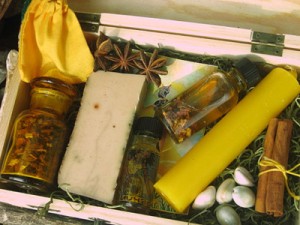
An “Orisha Box” sold by a vendor claiming it to be a portable altar to the orisha Oshun. Appropriation of orisha colors, symbols and numbers with no cultural context is another way vendors make money through cultural appropriation. Oshun is not worshipped in this manner in Lukumí nor Yoruba practice.
Cultural Appropriation is harmful for several reasons. First, it harms people because it is a colonialist objectification of ancient traditions. A minority people who have suffered the scourge of colonialism have a damaged sense of ancestry, have had their lands and power stripped away from them and have often been ripped away from their traditional religious practices. Their traditions are the last thing they can truly own when their land is gone, their families destroyed and their power stripped away. When a dominant culture comes along and objectifies indigenous practices so that they become a costume, a fad, a decorating motif or the flavor of the month, the culture of the oppressed minority is ridiculed and seen as a simple object that can be shuffled about, traded or purchased for money. It is the final blow to a minority oppressed people’s soul.
Secondly, these religious traditions were preserved for centuries by disciplined adherents to the faith, through hurdles to participation like intensive study and initiatory requirements, as well as keeping inner secrets guarded by the priesthood. Many ancestors died to preserve these traditions even in the face of slavery and persecution. For an outsider to come along and start wearing the false vestments of religious authority because they think an orisha is “pretty” or because “they love her” is insulting to the ancestors and reduces the ancient religious secret practices of that people to a mockery.
Third, cultural appropriation can lead to people of the dominant culture assuming they have privilege and the right to practice minority indigenous religious practices in which they have not been trained or duly initiated. This can result in them tampering with energies, deities, spiritualities, entities, spirits and forces they are not ready to deal with. Simply put, when a person dresses a fierce indigenous spirit in a warm-fuzzy, culturally objectified, “rounded-corners for your protection” colonialist attitude, she’ll find herself tampering with a force that will unbalance her life in no time.
Often those in the majority mindset will apply their cultural values to the situation to justify their attitude. Sayings like “The gods are love and they understand I am coming from the right place”, “She chose me to worship her” or “If we didn’t worship these Gods they’d probably disappear” are a perfect example of a privileged approach to indigenous culture and are hallmarks of cultural appropriation. (If you truly appreciated that orisha or those traditions you’d go to a culture bearer who worships in the manner that preserved that spirit’s practice and learn they way the orisha likes to be worshipped instead of assuming your way is right.)
Blending Hoodoo, Voodoo (Vodou), Santería, Palo, Obeah and Other African-Diasporic Traditions
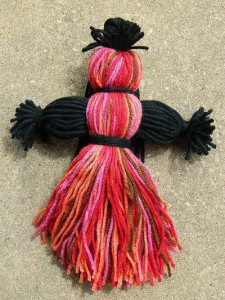
An “orisha spirit doll” sold by a vendor claiming it will allow the owner to petition the orisha Oya and gain blessings of prosperity. Oya is not worshiped in this manner, only spirits of the dead are housed in dolls in Lukumí practice.
A common red flag warning you that a practitioner is culturally appropriating without formal training or without respect for the individual traditions he or she is borrowing, is when you see someone blending multiple spiritual paths into one practice. These are each separate and distinct spiritual paths that have nothing to do with one another. (Read our article on the difference between Hoodoo, Voodoo and Santeria.) As was previously mentioned the tribes from where these practices originate were often mortal enemies and at war with one another in Africa and would not blend their traditions nor cross their practices. Even Vodou which does include elements from Fon, Ewe, Yoruba and Congo people (who often warred with one another) has a fixed “reglement” or traditional order that is followed in their religious practices, and it is not a free-for-all religion. Simply put, these are distinct practices and religious traditions. Someone can certainly be initiated in multiple traditions but is rare to find anyone who is initiated in more than two of them.
We’ve witnessed hoodoo spiritual supply shops selling “La Sirene/Yemaya” Oil, when these are two distinct and different spiritual forces from different tribes in Africa that never saw eye to eye.
We’ve seen “orisha spirit dolls” which are essentially rag dolls like the doll babies made in hoodoo, but in the colors of various orishas. The vendors claim they can be used to help the owner obtain blessings, money, protection, etc. There is no way to know what these dolls contain, neither in terms of physical components, nor in the spirits that might decide to reside therein. Without proper consecration, a doll is just a house for some spirit … any spirit … certainly not the orishas. And any spirit would be happy to receive the worship and attention the owner of this doll would give it.
We’ve seen online merchants selling a “Pomba Gira paquet (paket)” when pakets come from Haitian Vodou (where Pomba Gira is NOT worshipped) and Pomba Gira comes from Brazilian Kimbanda where pakets are not constructed nor used in her worship (not to mention that Pomba Gira is a CLASS of spirits and you need to specify which Pomba Gira you are working with). Pomba Gira would not be amused, nor would any initiated Vodowizan.
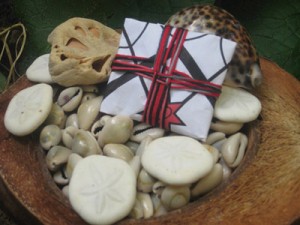
A “Pomba Gira” spirit paket sold by a vendor with no training in Brazilian Kimbanda. Pakets come from Haitian Vodou not Kimbanda, and Pomba Gira is a class of spirits, not one specific spirit. This is typical of fraudulent tradition crossing.
We’ve seen Etsy shops selling Palo trazos/firmas (sacred symbols of Palo Mayombe) when they are not initiated into Palo. We’ve even seen people selling Palo Trazos/Firmas drawn on cardboard like some kind of amulet to bring you money, protection or luck (even though trazos are drawn in the moment with chalk on the floor and are unique each time they are drawn and used . They are an instruction set to a spirit and without a nganga (pot) or a lucero they mean nothing.) Any palero would laugh at the illogic of this practice.
We even saw a YouTube video of an invented divination system called “hoodoo bone reading” that utilized orisha color symbolism and names from Santería practices but had Kimbanda pontos riscados dawn on a dish along with various random tokens representing different forces in a person’s life, and then tried to pass it off as Obeah divination. Which is it, Hoodoo, Santería, Kimbanda or Obeah? The answer is that it’s none of the above.
This mish-mosh of practices is a sad attempt to lend legitimacy to a fraudulent practice by adding more “mystically foreign” elements to the mix. It’s the attitude of “OH! Add that in there too … it will seem more spooky and exotic, thus POWERFUL!” Not only is this shoddy spiritual craftsmanship but it also causes those who may be sincerely interested in learning these traditions great confusion.
In the short time we’ve been online our church has received messages and questions from many people. We’ve had to explain to people that buying a catholic saint statue of Our Lady of Charity of Cobre does not mean you have received the orisha Oshun. That there is no such thing as palo “elekes”. That a hoodoo spell does not call upon the orisha Eleggua. That Yemaya cannot be contained in a mojo bag. And that you can’t buy a Fimo clay head made to LOOK like Eleggua online and think you actually have received anything of Eleggua.
This kind of fraud has to stop, and it is important that we call it out when we see it. People are scammed out of thousands of dollars falling for these tricks. We at SAFE are doing our part to inform the public about non-traditional practice but also about what IS traditional. Knowledge of how things are traditionally done is more important than anything, and will help the public stay away from these snake oil vendors.
Emulating Orisha Imagery in Statuary
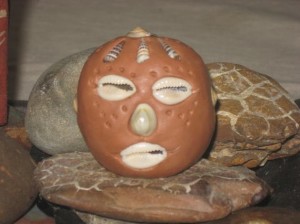
An “Eleggua” head made of red clay sold by an online vendor. Only an ordained Olorisha or Babalawo can construct such an item, and it would never be made of clay. This vendor has no initiations in Lukumí or Ifá. (Image updated to show the actual object sold online)
Another common example of cultural appropriation with online vendors is the proliferation of “Eleggua” statues being sold online. Elegguá’s shrine traditionally takes the form either of a single stone, or a cement head-shaped shrine into which have been placed cowries. Each Eleggua should be unique to the individual, containing items as divined through diloggún or Ifá, and proper to the camino (road) for that individual. Eleggua is always made of durable construction (like cement or a rock) not clay, nor polymer clay (Fimo or Sculpey) . Elegguá’s shrine must then be washed and consecrated in a long ceremony by initiated olorishas or a babalawo, and then fed animal sacrifice or it isn’t anything. Remember – no blood, no orisha.
We have witnessed red and black polymer clay sculpted heads being sold online with keys, feathers and cowries being jammed into the sculture. We’ve seen Eleggua-like heads sculpted out of play-doh, or red clay (claimed to have been hand-harvested from the great lakes region). We’ve even seen spirit bottles and mojo bags being made “for Eleggua” and sold as if they have anything at all to do with Eleggua. At best these are pretty crafts or art items, but they are most certainly NOT legitimate nor authentic Lucumí nor Yoruban shrines for the orisha Eleggua/Elegba.
(Please note, the image that was originally in this article depicting the Fimo clay Eleggua heads with keys, duck feathers, beads and crystals stuck in them has been removed because the online merchant who made them claimed ownership of the image. Per the request of Denise Alvarado – proprietor of PlanetVoodoo.com – and out of respect for her copyright ownership of the images of her Eleggua heads, we have removed the images but hold to our article’s point that this is an example of cultural appropriation since she is not an initiated orisha priestess in Lucumi, Ifá, Brazilian Candomblé nor any of the traditions that worships Eleggua in a clay head form, and has no right to make nor sell these things and claim they are Eleggua. While this artist has added a caveat to her website stating these are not made by a babalawo and are not presented as ritual items, her product descriptions and powers she ascribes to the articles clearly indicates that she is selling these sculptures as if they were sacred and ritually prepared including item descriptions saying they were “created within sacred space”. This is misleading at best.)
Non-Ordained, Non-Initiated People Acting as Priesthood
The other example we’ve seen are people acting as priesthood by working with clients, offering readings, leading public rituals, performing spells, selling items and shrines dedicated to Lucumí/Yoruban orishas when they have no ordination or initiation within the Lucumi or Yoruban traditions. To be very clear, before a person can work for clients on the behalf of the orishas, offer readings where the orishas speak, lead public rituals for the orishas, perform ebó or spells that petition the orishas, or construct/consecrate shrines for the orishas within the Lucumí or Yoruba traditions, you MUST BE AN ORDAINED PRIEST (Olorisha or Babalawo). Even within these traditions there are further limitations. (You cannot give a shrine or item of an orisha away if you have not received it first, etc.)
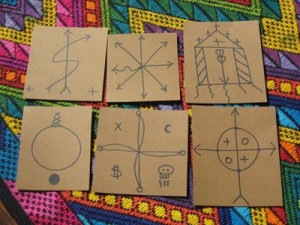
An online vendor sold these Palo Firmas drawn on cardboard as magical charms. The vendor has no initiation in Palo and these firmas are worthless without a nganga and palo initiation.
This problem is becoming a quite rampant within the neo-pagan community. Neo-paganism is a valid and distinct religion but it is not Lukumi nor Yoruban religious practice. While they may feel they have the right to worship our orishas, our orishas have made it very clear the manner in which they want to be propitiated and worshipped. This is contained within Odu (the signs of our divination system), preserved by ancestors who gave their lives through slavery and persecution to retain their native practices, and perpetuated into modern-day by contemporary practitioners who continue and carry on the manner of worship taught by our elders. It is incredibly insensitive and offensive for someone outside of our religion to think they have the authority to run a ritual to one of our orishas when they have not been properly initiated in our manners. It is a huge example of cultural appropriation.
Neo-Pagan priests and priestess are running amok claiming to be a “Priestsess of Oshun and Yemaya” or “a daughter of Oya and Ogun” when they have never been through kariocha nor been initiated into Ifá. Even in our religious practice we do not know who are spiritual parentage is until itá (the life reading performed three days after initiation). This creates a shadow culture to our traditional Lucumí/Yoruban practice where people think they can go to a pagan priest to work with the orishas or that they can go give offerings to any orisha in nature while singing pagan songs. While I am sure they have good intentions and are coming from a place of genuine interest and heart, I ask them a very poignant and important question. “If you love the orishas so much, why don’t you learn the way that orisha wants to be worshipped, from the people who preserved that tradition for centuries?”
Typically when these folks are challenged they’ll take one of two roads. The first direction are the folks who claim that “this is how I was taught by my family / mom / grandmother, etc.” (It’s interesting to note that no one ever claims their father or their grandfather taught them these things.) They claim to have been taught to make Haitian-Brazilian-Hoodoo items by family, or that they were taught that the orishas were part of Voodoo, or that “this is they way I was shown it was done”. No one in the USA even knew (or cared) about Pomba Gira until the 21st century and suddenly people are claiming they had family traditions that worked with her (although they have no ancestry in Brazil). Or some even claim to come from a family lineage of Chalcedonian witches – from ancient Chacedon in Turkey, who never worked with the orishas, pomba gira, the lwa, etc. Anyone who has a real root in these traditions would never condone that these practices be mingled.
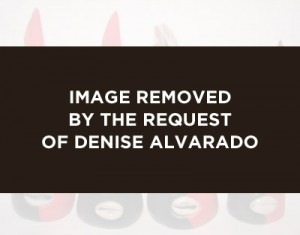
“Crowned Eleggua” statues made of polymer clay (Fimo) with keys and random items added in. Eleggua must be made of a durable material like stone or concrete and customized through divination. These were sold online by PlanetVoodoo.com – image has been removed by the request of Denise Alvarado as she holds the copyright for the photo.
The second road people usually take is to claim these practices as “their own private spirituality” and “how dare you question me or make me have to explain myself” for doing what they do. Well simply put, we as actual initiated priests and priestesses who entered igbodú (the sacred room), who wen through initiation, who paid our dues and sacrificed our lives for the orishas, are the culture bearers of this religion. We practice it as the priests who initiated us practiced it. We have verifiable lineages that are a testament to our initiation, to the preservation of our culture and to the perseverance of our ancestors in the face of adversity. We honor their sacrifice by practicing our religions the way they did – not by inventing stuff because “we feel we have the right to”.
To those who are appropriating our religions, If someone steps up to call you out on your own “inventions” then don’t be offended when they call you exactly what you are… an inventor. Fly your inventor flag with pride and let people know “Hey this is my own mish-mosh I invented and it’s pretty and I like it”. That’s fine. But don’t try to pass yourself off like some kind of authority … neither by family lineage nor by self-rigteousness.
To the public… ask questions about everything! If it’s boasts a lot and claims to be something authentic, do some research before you buy it. Ask around and see what others think of their practice. Ask outside of their sphere of influence so you can get an honest, unbiased opinion before hiring one of these individuals and always ask for credentials. A true santero or babalawo can tell you where they come from with specific names, dates and places, not veiled mysterious stories about family traditions, grandmothers or divine intercession.


 Pagan Blog Project
Pagan Blog Project
Follow Us!